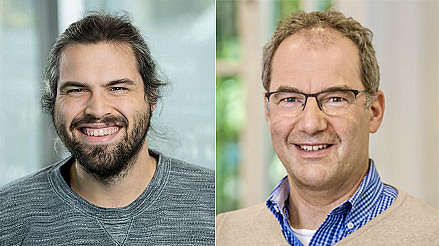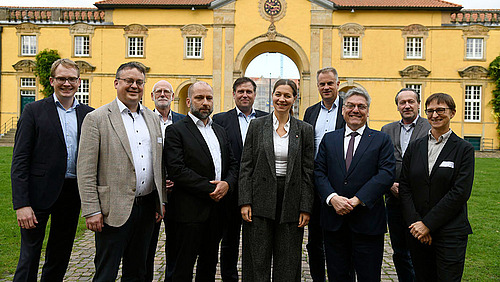Calcite is one of the most common minerals on earth and plays a central role in natural and technical processes. "By understanding how water interacts with the calcite surface, we can better answer important scientific and socially relevant questions - from climate protection and environmental protection to the development of new materials," explains Osnabrück physicist Dr. Philipp Rahe.
Using a particularly sensitive technique, high-resolution atomic force microscopy, the Osnabrück researchers have succeeded in imaging the arrangement and orientation of individual water molecules on the surface of calcite. To do this, an atomically sharp tip with a single carbon monoxide molecule attached to its end point is brought close to the water-covered calcite surface. The force acting on this tip is caused very locally and enables measurements with extremely high sensitivity and resolution on a subatomic scale. These forces are mapped by scanning the surface line by line, thereby creating an image of the atomic structure.
"During the experiments on individual water molecules, we observed very early on that there appear to be two types of water molecules on the calcite surface. This was astonishing, as no difference between these water molecules had previously been observed in the literature in a closed water layer," says Dr. Rahe, in whose junior research group "Molecular Quantum Structures" at the School of Physics the experiments were carried out. "We first had to carry out some developments in preliminary experiments, such as a special sample holder and special measurement protocols, in order to be able to carry out these investigations of individual water molecules," adds Dr. Jonas Heggemann, the first author of the study.
Dr. Philipp Rahe and his team recently clarified the structure of the calcite surface and identified a surface reconstruction, i.e. a rearrangement of the atoms in the uppermost layer of the surface. This reconstruction results in two different positions where water can bind to the surface. "The amazing thing about this system is that the water cancels out the difference between these two positions, it literally pulls on part of the surface atoms," explains Dr. Rahe. In collaboration with Prof. Adam Foster and Jie Huang from the University of Aalto in Finland, this process could be precisely understood in the current study using ab-initio simulations: While the binding of water at the first position is accompanied by only a minimal change in the surface, at the second position the surface atoms move from the reconstructed structure back to the original crystal structure. This process is caused by a single water molecule and requires energy. Therefore, water binds differently to these two positions, although the local geometry is identical.
The project was supported by the German Research Foundation and Osnabrück University.
Publication:
Sidestepping intermolecular hydrogen bonds: How single water molecules adsorb and assemble on the calcite(104)-(2×1) surface.
J. Heggemann, J. Huang, S. Aeschlimann, S. Spiller, A.S. Foster, P. Rahe
ACS Nano (2025), DOI: 10.1021/acsnano.5c05845
https://doi.org/10.1021/acsnano.5c05845
Further information for editors:
Dr. Philipp Rahe, Osnabrück University
School of Physics
philipp.rahe@uni-osnabrueck.de





